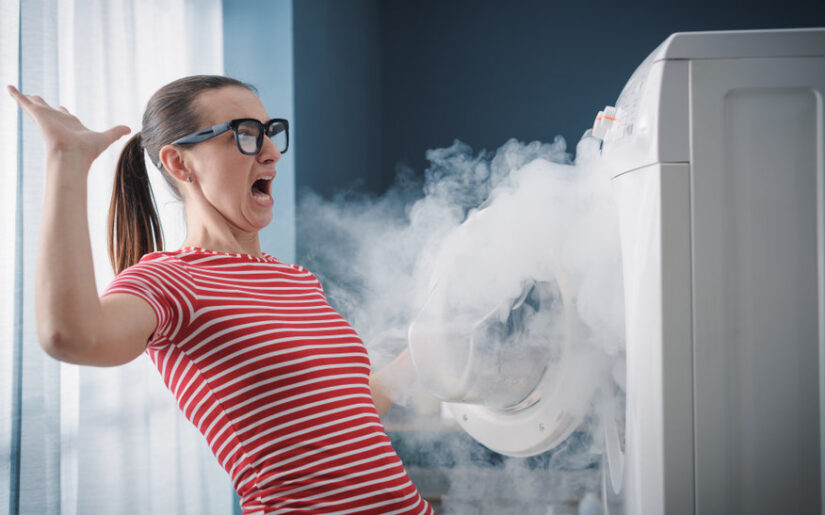A dryer is almost part of every household, and it is one of the most convenient tools for keeping our clothes dry in good condition. However, we may experience some inconveniences and severe problems with our dryer over time. Thus, it can be served us up to 10-15 years, and by ensuring the proper condition, it may also take much longer.
But what if the dryer makes an obnoxious noise? Is the noise a significant issue? Many of the potential causes will necessitate the assistance of a professional repair technician. Fixing a noisy dryer isn’t as challenging because they have the right tools and skills. However, it is critical to troubleshoot the problem because it will save time and may prevent even more severe problems from occurring. For some instances, the dryer cabinet may need to be removed from the dryer to diagnose and repair these issues. Let’s learn more about the dryer to ensure that we have enough knowledge of this valuable equipment.
Looking at the Causes
We’ll examine the causes of dryer noise and how to mitigate or eliminate it. Let’s begin with the cause of the dryer’s irritating noise. These critical components of the dryers that may cause noise should be thoroughly inspected and coordinated with a professional if they cannot perform appropriately after troubleshooting.
Here are the dryer parts that need to look out;
Drum Roller Axle
Worn-out rollers are one of the most common reasons for unusual dryer noises. They support the dryer drum as it rotates, which can make a lot of noise. Furthermore, some dryer models feature two back rollers, while others have two front and two rear rollers. The rollers keep the dryer drum stable as it turns. Also, Axles are the shafts that hold the drum rollers at the front and back of the dryer. The axles on which the rollers rotate are also susceptible to damage.
Drive Belt
A broken drive belt can also cause dryer noise, part of the pulley system that turns the drum into dryers. If it’s broken, it won’t be able to turn the drum right and will make a loud thumping noise.
Idler Pulley
Due to defective idler pulley will make a loud squeaky noise, but it can worsen and make a thumping or scraping sound. Idler pulley keeps the drum belt tight, so it doesn’t slip when the dryer has many clothes.
Blower Wheel
If you do not maintain the blower wheel, it may become unbalanced, loose, or clogged with lint. Following that, there may be some noise that sounds vibrating or thumping—this is caused by using the rear exhaust vent to blow moist air out of the dryer drum through the blower wheel.
Drum Glides
Made of Teflon, nylon, or plastic, the drum slides with small plastic pieces fall onto the drum as it rotates and causes a noisy dryer. They have a felt or cork backing to provide a smooth surface for the drum to spin on. If the drum slides become damaged, they will generate a grinding noise.
Drum Bearing
The bearing might be a ball and socket or a shaft linked to a sleeve bushing. Depending on the dryer brand, some drum bearing supports the rear of the dryer drum. However, it is positioned behind the dryer drum and will rub against the back of the case if the drum bearing wears out, causing a screeching or grinding noise.
Lifter/Baffler
The baffles or lifters within your drum keep clothes from adhering to the inside and help them tumble and fluff as they dry. Small items can get caught and rattle around. Worn or open baffles can clump and harm your clothes.
Drive Motor
The drive motor rotates the dryer’s two components, the dryer drum, and the blower wheel. If the bearings need a replacement, the drive motor may produce a screeching noise, a humming noise if the switch is faulty, or a rattling noise if the motor pulley is loose.
Drum Seals
The drum seals operate as cushions between the drum and the front and rear bulkheads, preventing extra air from entering the dryer drum—a felt-like material used to make the drum seals. Clothing might become stuck in the gap as the drum turns if the seal is torn or worn. It might cause a scraping or banging sound, ripping,g or black markings on the clothes.
Discover the Solutions
Drum Rollers. The rollers that support the drum in your dryer might wear down and produce much noise. Therefore, it is advisable to replace the entire rollers, not just the broken ones.
Drive Belt. It doesn’t take long to remove and change the drive belt. By opening the dryer, you can look at the drive belt. A drive belt wraps around and threads over the idler pulley in this picture. It then loops over the driving shaft. If you find belt fragments inside the dryer, that’s a good sign that it needs to be changed.
- Idler Pulley – To look at the idler pulley, you’ll need to take the dryer cabinet off of the wall first. The idler pulley is next to the motor pulley, and the drive belt runs around it and the motor pulley as it moves. So if the drive belt is off the idler pulley, you can turn the pulley by hand to see if it makes a noise.
- Drum Gliders – On most types, drum glides are usually fitted on the front bulkhead, either at the top or bottom. Examine your slides for signs of wear or damage visually. If any of your drum glides seem worn, you’ll need to replace them. Many would advise removing worn-out drum sliders and removing the dryer cabinet if they start to unravel. Depending on the model, some glides require drilling out rivets while others are screwed in.
- Drive Motor – To inspect the motor, remove the dryer cabinet and drum. A motor drives the blower and the drying drum in gas and electric dryers. A rattling noise caused by a loose pulley, a high-pitched noise caused by a broken bearing, or a humming noise caused by a lousy winding or motor switch indicates something is wrong with the engine. Next, open the drive motor and turn it to hear if it makes any strange noises, and using a multimeter, you can test the machine. Touch each probe of your multimeter to one terminal and set to Rx1. Your motor should read zero or close to zero. Then, one search on the engine’s bare metal casing and one on each terminal to check the ground connection. This test should provide no results. If your motor fails one of these tests, replacement is needed.
- Drum Bearing – Remove the dryer belt and turn the drum by hand to see if the drum bearing is broken and needs to replace. The drum bearing is unlikely to be worn out if the drum rotates freely. Replace the drum bearing if it creates screeching or grinding noises when turned.
Another effective solution is to get a dryer maintenance kit if your dryer is creating noise and you’re unsure which part to replace. The dryer maintenance kit includes all of the factors that are typically malfunction when the dryer is noisy. To discover the appropriate maintenance package for your dryer, look up your model number.
Tips to Mute a Noisy Dryer
Quickly remove the dryer from the wall, away from the washer and other furniture. It shakes and vibrates when a dryer operates, producing a rattling or resonant sound. According to the manufacturer, if you hear repeated tapping or a very loud fibration in sync with the dryer, something is striking and shaking it.
Uneven dryers make noise because the drum does not spin uniformly. So, ensure the level of your dryer to the floor. Then, adjust the dryer’s feet to a bubble level.
Cleaning your dryer’s vents and the entire unit is crucial. However, lint can accumulate within the dryer or other heating devices and the vent.
Ensure adequate air circulation surrounding the dryer vent. If you can’t see air leaving while the dryer is running, unplug the duct and clean it thoroughly. Then, reconnect everything before starting your next load.
Takeaway
Dryers can generate unexpected noises that can quickly resolve. First, homeowners must follow the standards used to avoid serious problems. Some of the critical notes to keep in mind are to unplug the dryer cord from the outlet or switch off the power supply. Also, ensure that pants pockets are free from small items to avoid damage. Next, check the area surrounding the dryer for anything leaning against it. Finally, always leave enough room between the washer and dryer to prevent colliding while operating.
Most significantly, stop using a dryer and contact a specialist for an inspection and repair if the dryer noise persists after troubleshooting. To ensure that the dryer is working and repaired correctly. And that you receive professional help, contact a professional dryer maintenance specialist in your area. They are the appropriate solution because they all possess the necessary equipment and expertise to meet the needs of each consumer.


